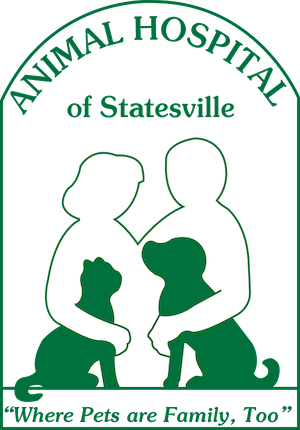DV - Gastric Dilation or Gastric Dilation (or Dilitation) Volvulus
- Dr. Nichola Gaither
January, 2020
You know that feeling you get around this time of year when you've eaten too much of the yummy foods like pumpkin pie? You have overindulged and your stomach feels bloated and ready to explode? In this Doc Talk, I'm going to talk about that. Not in humans, but in dogs. In dogs, we call that condition gastric dilation or dilatation. Basically, that's when there is too much ingesta (or food) or air that fills the stomach really full and it gets really big. Then, there is an obstruction, either mechanical or functional, to the outflow or release of that ingesta or air, and it doesn't have anywhere to go. A few risk factors or causes of this condition are: 1. Being a large breed dog (although it CAN happen to smaller breed dogs and even cats, but it's not as common). 2. Eating really large meals all at one time. That ingesta fills the stomach and it just doesn't have anywhere to go and doesn't give the body time to digest it. 3. Exercising right after eating. You've heard the saying "Rest and digest"? That's good advice! Let your pet digest his food and not go out running or chasing the ball. 4. Stress. Stressful events can increase the risk of bloating. When a pet is stressed, a lot of times they do a lot of barking, and they might pant a lot whenever they are nervous. When that happens, they ingest air, and again, air fills the stomach and has nowhere to go due to some kind of obstruction.
One thing that can happen when the stomach dilates or bloats is that it can twist. The medical term for that is volvulus. You may know the term GDV - Gastric Dilation (or Dilatation) Volvulus. GDV is a life-threatening surgical emergency for dogs.
Signs and symptoms of GDV? The stomach may swell after eating. You may be able to actually see your pet's abdomen grow larger. It may look like they've swallowed a basketball. Your pet may be restless and not able to get comfortable. The dog may act lethargic. Vomiting may occur, or they may do a lot of retching or dry heaving and nothing comes up. These are all really important signs to look for. If you suspect GDV, seek veterinary care for your pet IMMEDIATELY!
When you take your pet to the veterinarian, the first thing they will do is examine your pet. Sometimes, just by the physical exam, they can determine if your pet, in fact, has a distended stomach. The next thing they will most likely do is a radiograph. The x-ray can confirm a distended stomach, as the veterinarian can see the swollen stomach, filled with air, and (as in our example in the video) air in the intestines. Air shows up as black in the radiograph.
How can you help your pet minimize the risks of GDV or bloat? Feed smaller meals. The body is able to digest smaller meals more quickly, and more easily. Wait a bit after they eat to exercise them. Give them time to digest their meal. Avoid stressful situations as best you can. Again, when they bark a lot and pant a lot, they are sucking in air, and that can increase their risk.
If you have a large breed dog, one preventive surgical procedure your veterinarian can offer is a gastropexy. Gastropexy basically involves tacking the stomach to the body wall. This procedure doesn't prevent your pet from bloating in the future, but it DOES prevent that life-threatening twisting or volvulus that can happen.
Remember, GDV is a life-threatening condition and emergency veterinary care is required! If you suspect this condition, don't wait! Take your pet to the veterinarian or emergency clinic immediately!
With these tips on preventing bloat in the first place, you may be able to save your pet from this very painful, very dangerous condition.

